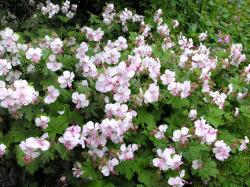2015 Perennial Plant Of The Year – Geranium Xcantabrigiense 'Biokovo'
March 6, 2015 | 3 min to read

Geranium xcantabrigiense ‘Biokovo’ is the 2015 Perennial Plant of the Year™. Geranium xcantabrigiense ‘Biokovo,’ pronounced jer-AY-nee-um kan-tuh-brij-ee-EN-see bi-o-KO-vo, carries several common names including Biokovo geranium and cranesbill Biokovo. The plant is a member of the Geraniaceae family.
Hardiness: USDA Zones 4 to 8
Light: Bikovo performs best in sun to partial shade.
Soil: This geranium prefers average, well-drained soil.
Uses: This perennial offers beautiful brightness and delicate scent in lightly shaded, partly sunny areas at the front of borders or as a grouncover.
Unique Qualities: 'Biokovo' showcases delicate pinkish-white flowers in spring, that give way to beautiful reddish orange fall leaf color.
Dr. Hans Simon, Marktheidenfeld, Germany, found ’Biokovo,’ a naturally occurring hybrid of Geranium dalmaticum and Geranium macrorrhizum, in the Biokovo Mountains of the Dalmatia region of present-day Croatia. Geranium is derived from Greek “géranos”, describing the cranes bill-appearing fruit and the Latin “Cantabrigia” for “of or pertaining to Cambridge, England.”
‘Biokovo’ blooms in late spring with delightful masses of 5-petaled white flowers, about 3⁄4” diameter. This excellent groundcover perennial reaches 6-10” high. Petals are tinged pink at the base and have darker pink center stamens. The overall effect is that of a blushing pink geranium. An interesting attraction is the flower ‘bud’ that is somewhat inflated – actually made up of the sepals which are redder than the petals. When the flower opens the lightly tinged pink flowers provide a handsome contrast to the sepals and stamens. The aromatic foliage has rounded leaf edges, is a medium green color, and is semi-evergreen in most climates. It forms an attractive mound that offers scarlet and orange fall colors.
‘Biokovo’ does well in average, medium, well-drained soil in full sun to part shade. It is easy to grow and only requires deadheading (removing old flowers) to keep it looking good. It forms an attractive mound that offers scarlet and orange fall colors to your garden. Cut away any dead foliage in the spring and ‘Biokovo’ is ready for the garden season. The plant tends to be deer- and rabbit resistant.
This geranium spreads by sending out runners, or rhizomes. However, not being a deeply rooted perennial, removal is not strenuous. Best garden placement is as a ground cover or in the front of the border. It also does well in rock gardens.
Plant ‘Biokovo’ next to Japanese painted fern. Pick up color echoes between the pink flowers and maroon foliage tones that contrast with the silver streaks in the fern fronds. It also pairs nicely with late spring blooming penstemons such as ‘Prairie Dusk’ with clear purple flowers, or ‘Pink Rock Candy’ offering bright pink flowers on compact stems.
Contributor: Martha A. Smith, Horticulture Educator, University of Illinois Extension
Images: Todd Boland, Steve Still, Bachman’s Inc.
The Perennial Plant of the Year™
The Perennial Plant of the Year™ (POY™) program began in 1990 to showcase a perennial that is a standout among its competitors. Perennials chosen are suitable for a wide range of growing climates, require low maintenance, have multiple-season interest, and are relatively pest/disease-free. If you are looking for an excellent perennial for your next landscape project or something reliable for your gardens, make sure to check out the Perennial Plant of the Year™ archive list. For information about other perennials, be sure to search the Plant Database.
Since the Perennial Plant of the Year™ was introduced in 1990, the Perennial Plant Association has received frequent inquiries about how the Perennial Plant of the Year™ is selected. The selection process is quite simple – PPA members vote for the Perennial Plant of the Year™ each summer. At that time, in addition to the vote, each member may also nominate up to two plants for future consideration. The Perennial Plant of the Year™ committee reviews the nominated perennials (more than 400 different perennials are often nominated each year) and selects 3 or 4 perennials to be placed on the ballot.
Nominations generally need to satisfy the following criteria:
- Suitability for a wide range of climatic conditions
- Low-maintenance requirements
- Relative pest- and disease-resistance
- Ready availability in the year of promotion
- Multiple seasons of ornamental interest
Source: Perennial Plant Association
